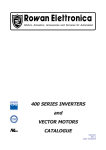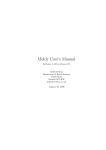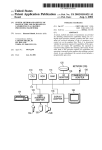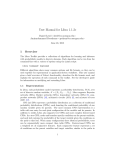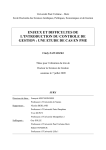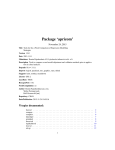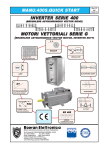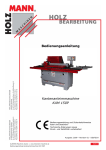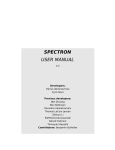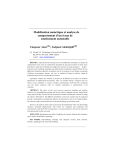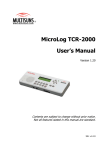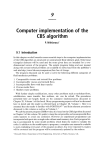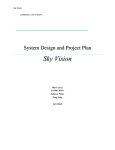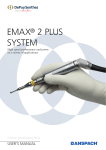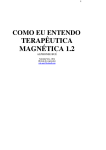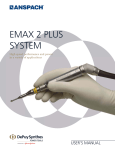Download Revision History - Climate & Space Research
Transcript
MultiWell Program Suite: Revision History If you notice surprising behavior, it may indicate a bug. Please let us know right away. We try very hard to fix bugs as soon as we know about them, and then post the latest MultiWell release on the website. THANK YOU FOR REPORTING BUGS! NEW IN VERSION 2014.1 (June 2014): 1. MultiWell: new feature: by optionally adding a single keyword, energy transfer is treated in the traditional manner, instead of the default, which is to attenuate the inelastic collision frequency (and hence the rate of energy transfer) at low energies, where the densities of states are very sparse (see J. R. Barker, Int. J. Chem. Kinetics 41, 748 (2009)). The traditional method was based on the convenient assumption that the inelastic collision frequency is independent of internal energy. This feature facilitates inter-comparisons between multiwell and other master equation codes. 2. DENSUM: new feature: an additional output file is now generated by the code: "densum.lev". This file summarizes all of the energy levels utilized in computing the sums and densities of states for each built-in quantized degree of freedom (vibration, particle-in-a-box, free rotation, and hindered rotation). 3. LAMM: Improvement: the output was revised in order to write out more significant digits. 4. Hindered Rotor Treatment: Improvement: From a comparison between the hindered rotor treatments in MultiWell and MESMER, it was apparent that we needed to use more grid points in order to achieve the desired accuracy at very high eigenvalue energies. As a result, we increased the number of grid points from 201 to 501. This slows down execution times, but achieves better accuracy at high energies. The eigenvalues at lower energies were already quite accurate and thus this change had very little effect on practical calculations. (Thanks go to the MESMER Team for participating in this master equation inter-comparison (MEIC) activity. For more information about the MEIC activities, contact [email protected].) Only the above programs were modified for this particular release. NEW IN VERSION 2014 (January 2014): 1. MULTIWELL: Bug Fix: when densities of states are sparse (e.g. for small molecules at low energies), tunneling from one Well to another was allowed to take place, even when tunneling into an energy grain that did not contain a state (an "empty grain"). In this event, the stochastic trial did not terminate correctly. This problem has now been addressed by forbidding tunneling into an empty grain and issuing a warning in the rate constant tables in the output files. However, note that this pragmatic "fix" -1- MultiWell Program Suite: Revision History does not address the more fundamental problem that wells connected by tunneling should possess states in matching energy grains. Fortunately, the effects of this problem are small, except at very low energies in very small molecules: it does not occur at all in models that do not contain empty grains. Probably, very few users have been affected. If more information is needed, contact [email protected]. 2. MULTIWELL: Improvement: the format of output file "multiwell.dist" was revised to make it more convenient for users, although the file is now larger than before. 3. MULTIWELL: Improvement: For convenience, the temperature dependence of the collisional energy transfer parameter ALPHA has been revised to the following form: Alpha = [C(1) + E*C(2) + E*E*C(3)]*(T/300)**C(8) Previously, the constant term, C(1), was not multiplied by the temperaturedependent factor. Furthermore, the temperature-dependent factor was changed by replacing T with the ratio T/300. All of the temperature dependent factors have been changed analogously. The revised form is expected to be more convenient for users. 4. DENSUM: Bug-fix: A minor bug prevented calculation of sums and densities of states using the KRO degree of freedom. This bug has been fixed. Since this degree of freedom is not employed routinely, this bug probably did not affect any users. 5. THERMO, MOMINERT: improvement: in both of these codes, it is now an option to use user-defined filenames with extension ".dat" for the data file (e.g. "C2H5.dat") in place of the default names (defaults: "densum.dat" and "mominert.dat"). The output files take the user-defined file name with extension ".out." (e.g. "C2H5.out") in place of the default names (defaults: "densum.out" and "mominert.out"). 6. ADENSUM: Bug Fix: ADENSUM can be used with THERMO to compute thermodynamic data and canonical TST rate constants for fully vibrationally-coupled anharmonic molecules and transition states. It does this by passing a data file (with the ".qvib" suffix), which contains partition functions, zero point energy, etc. When separable degrees of freedom (e.g. hindered rotors) are included in the ADENSUM calculation, their zero point energies should have been added to the anharmonic zero point energy, but were not. This omission has now been fixed. 7. gauss2multi: revision: When using gauss2multi to create data files for the MultiWell codes, Users must specify pressure units, which are used only for creating "multiwell.dat". The thermo.dat data file requires specifying the standard state, but TOR pressure units are not an allowed standard state and previous versions would give error messages when creating thermo.dat. The gauss2multi code has been revised so that thermo.dat is created with "BAR" as default when TOR units are specified by Users (thus avoiding unnecessary error messages). Other data files created by gauss2multi are not affected; in particular, multiwell.dat can still be created with TOR pressure units, when they are specified. -2- MultiWell Program Suite: Revision History 8. In the User Manual and in the output files from the various codes, the hindered rotor degree of freedom that was previously described as an "Unsymmetrical hindered rotor" (hindered rotor type "hrd"), is now described more properly as a "General hindered rotation". This change was made because the hrd type could always be used for any 1-D hindered internal rotation, symmetrical, or unsymmetrical, although it is particularly useful for the latter. NEW IN VERSION 2013 (January 2013): 1. MULTIWELL: extension: input for the number of stochastic trials (NTRIALS) can now be formatted as either REAL or INTEGER in data file multiwell.dat (previously it was just INTEGER). It is more convenient to enter "1.e+7" instead of "10000000". 2. MULTIWELL: improvement: A more accurate expression for the collision integral for Lennard-Jones collisions has been adopted in this version. Previously, MultiWell used the simple version described by Troe [J. Chem. Phys. 66, 4758 (1977)], but with this version, the more accurate expression of Reid et al. has been adopted [Reid, Prausnitz, and Sherwood, The Properties of Gases and Liquids: Their Estimation and Correlation, 3rd Edition, McGraw-Hill, New York, 1977]. For T ≥ 300 K, the two expressions give results that differ by 5-10%; the differences may be larger at lower temperatures. 3. THERMO: improvements: (a) The input "read" statements were slightly revised in order to allow users to add comments on the line for each electronic state (Line 11 of input data file "thermo.dat"). (b) Error messages were added or revised to give better feedback about errors in the input file. 4. ITEM OF INTEREST: master equation inter-comparisons: A number of us who develop and use master equations are undertaking inter-comparisons of the various codes. This activity will help us to identify possible deficiencies in our codes, as well as possible new enhancements. The user community can eventually expect not only better codes, but a better understanding of which codes are best suited for treating particular classes of problems. So far, the Master Equation Inter-Comparison Group (the MEIC Group) includes the developers of MultiWell and MESMER, Bill Green's group (MIT), Luc Vereecken (MPI-Chemie, Mainz), and Matthias Olzmann (Karlsruhe) — all of whom have contributed output for inter-comparison — and a number of other individuals and groups who have expressed interest. If you wish to be added to the list, please send a message to John Barker ([email protected]). NEW IN VERSION 2012.2 (July 2012): 1. USER MANUAL: (a) A discussion of the separable rotors approximation for treating external rotations was added to Section 9.4. This discussion explains that the approximation is most -3- MultiWell Program Suite: Revision History accurate when the rotational constant for the K-rotor is assumed to equal the unique rotational constant (i.e. BK = A), instead of the rotational constant for a symmetric top (i.e. BK = A − <B>). (b) More descriptions of "How to…" have been added to Chapter 10. More such descriptions will be added in future releases. 2. MULTIWELL: bug fix. The option to include the effects of slow intramolecular vibrational energy redistribution (slow IVR) was not working correctly, possibly due to an earlier maintenance revision of the code. The option has been fixed. 3. MULTIWELL: revision. The code now issues a warning when centrifugal corrections cause the critical energy Eor to be less than zero for RRKM input with key word "SUM". The warning is issued because in most cases Eor < 0.0 is non-physical. 4. MULTIWELL: extension. A new key word has been implemented: CRP (for "Cumulative Reaction Probability") designates a new category of input created using Semi-Classical Transition State Theory (SCTST). This new key word is analogous to "SUM", except that no warnings are issued when centrifugal corrections cause the critical energy Eor to be less than zero (this condition is usually not non-physical when using SCTST to generate the CRP). The input file is designated using suffix ".crp" (instead of ".dens") and has the same format as files with suffix ".dens". 5. THERMO: bug fix. The option to include symmetric top rotations with the proper constraint on the K quantum number (for specified total angular momentum J) was not working correctly. The option has been fixed. 6. GAUSS2MULTI: bug fix. Occasionally, the name and energy fields in some data lines would run together, causing errors. This problem has been fixed. NEW IN VERSION 2012.1 (April 2012): 1. THERMO: revision. A minor change was made to the format of the output file (thermo.out. The electronic partition function (Qelectr) is now tabulated as a function of temperature in the main output table, along with the heat capacity, entropy, and enthalpy function. The previous format was inconvenient when more than 5 temperatures were calculated. This revision does not affect any numerical values. 2. Gauss2multi: bug fix. A minor change bug prevented proper creation of data files for mominert (the length units were not specified). This bug was fixed by specifying ANGS (for Ångstrom units) as default. If other units are used (e.g. Bohr), Users will need to revise the mominert.dat data files manually. -4- MultiWell Program Suite: Revision History NEW IN VERSION 2011.2 (August 2011): 3. MULTIWELL: bug fix. The input for multiwell external data files containing k(E) (i.e. "____.rke" type files) was revised to make the order of input parameters consistent with other external files (i.e. "___.dens" files) and with the User Manual. In particular, the order of input parameters should be as follows in Line 3 in "____.rke" type files: Egrain1, imax1, Emax2, Isize, Viblo. Previously the input was inconsistent with the User Manual and with the other external file types. Note that this ordering of parameters is not the same as in multiwell.dat. 4. MULTIWELL: bug fix: The convenient capability for using a User-defined data filename was broken in a previous revision, although the default filename ("multiwell.dat") still worked correctly. This bug has been fixed. 5. MULTIWELL: enhancement: The centrifugal corrections were extended to include up to three adiabatic rotors (as in spherical tops like methane) by using Keyword "CENT3". When CENT3 is invoked, none of the external rotors is active and none should be included with the vibrations when computing the sum and density of states. 6. MULTIWELL: enhancement: The numerical integration subroutines used to compute the "informational" k∞ and kosc (high and low pressure limiting rate constants) were improved significantly. Depending on the temperature and the energy grain in the upper part of the double arrays, k(inf) and kosc (printed in the table describing the transition states) were in error by amounts varying from ~1% up to nearly a factor of x2. The largest errors occurred when the maximum energy in the lower part of the double array (Emax1) was less than kT and at the same time the energy grain in the upper part of the double array (Egrain2) was a substantial fraction of kT. The code has been revised in order to greatly reduce the dependence on user choices for energy. For best accuracy, Egrain1 should be smaller than 10% of kT (5 to 10 cm-1 is usually a good choice) and the double arrays should be constructed so that Egrain2 is less than kT/2. 7. SCTST: bug fix. A minor bug resulted in a very small error in the cumulative reaction probability at very low energies and in the computed partition function at temperatures below 50 K. This bug probably had no effect on any users, and it has been fixed. 8. SCTST and THERMO: modifications. To improve both accuracy and convenience, two modifications were made: (1) the vibrational partition function which is written by SCTST to the file with suffix ".qcrp" and used by THERMO is computed at 100 temperatures instead of the 50 used previously. (2) The zero of energy for the partition function is now located at the zero point energy of the transition state, instead of the ZPE of the reactant, hence making it more convenient to use the same computed partition function for both the forward and reverse reactions in THERMO. -5- MultiWell Program Suite: Revision History 9. ADENSUM and THERMO: modifications. To improve accuracy, the vibrational partition function which is written by ADENSUM to the file with suffix ".qvb" and used by THERMO is computed at 100 temperatures instead of the 50 used previously. 10. MOMINERT: new feature. Mominert will now accept molecular Cartesian coordinates in units of either Ångstroms or Bohr (previously only Ångstroms were accepted). After the TITLE line in the data file (mominert.dat), a new line with a keyword must be entered: 'ANGS' or 'BOHR' (all lower case is also accepted). 11. DENSUM: bug fix: some compilers generated code that failed to execute, due to the sequence of statements at the beginning of this program. This problem has been fixed. Probably very few users were affected by this problem. 12. User Manual: update: The User manual has been updated. In addition, a new "How to…" section has been added and will be further extended in future releases. NEW IN VERSION 2011.1 (March 2011): 1. MULTIWELL: error found and corrected. It was discovered that we did not implement the centrifugal corrections correctly. Although we used the approximate centrifugal correction described by Marcus [1966], the approximate k(E) was not properly averaged over the thermal rotational distribution. As a result, the following factor was omitted: C = (I+/I)exp(1-I+/I), where I+ and I are the moments of inertia of the adiabatic rotors in the transition state and in the reactant molecule, respectively. For tight transition states (I+ ≈ I), C is nearly equal to unity, but it can be much smaller than unity for loose transition states. Thus k(E) was larger than it should have been, which made collisions less competitive, when all other factors were held constant. This had several effects: (a) larger values of the energy transfer parameter alpha (average energy transferred in deactivating collisions) were required in order to fit experimental data; (b) at low pressures, collisions were less efficient than they should have been, affecting the rate constant at low pressures; (c) the relative rates in competitive multi-channel reactions may have been affected to some extent; (d) the decay of fractional population was faster than it should have been, leading in some cases to rates greater than k(infinity). The effect of this error ranges from negligible to significant, depending on the specific simulation. The last effect was only detectable when k(uni) was large enough for multiwell to be used effectively for thermal reaction rates (i.e. only for reactions with very loose transition states at relatively high temperatures). The error was corrected and new capability was added: the number of adiabatic rotations can now be selected (previously it was always assumed that two rotations are adiabatic). For users, the only change is in the keyword calling for -6- MultiWell Program Suite: Revision History centrifugal corrections. Four keywords are now recognized: NOCENT (no centrifugal corrections), CENT1 (centrifugal correction assuming one adiabatic rotor), CENT2 (centrifugal correction assuming two adiabatic rotors; this should be the usual choice), CENTX (legacy centrifugal correction, which is incorrect and not recommended). The User Manual will soon be updated to reflect these changes and to provide a more complete explanation of the centrifugal corrections. If in the meantime you need more detailed information, please send a message to [email protected]. 2. THERMO and MOMINERT: enhanced capability: many more elements and isotopes are now recognized automatically by these programs. The User Manual will soon be updated to reflect these changes. NEW IN VERSION 2011 (January 2011): New Capabilities 3. New computer code: sctst. This code implements the semi-classical transition state theory (SCTST) formulated by W. H. Miller and coworkers. With this new program, the SCTST can be applied to polyatomic systems containing up to dozens of atoms. It includes full non-separable coupling among all vibrations (including the reaction coordinate) and treats rotations as separable degrees of freedom. The SCTST automatically includes multidimensional quantum mechanical tunneling along the curved reaction path. The new code generates a standard output file, a file intended as input for MultiWell (for master equation calculations), and a file intended for input for Thermo (for computing thermal rate constants). 4. adensum: New Feature. Because computation of fully coupled vibrational states may be time-consuming, the new version of adensum now allows the user to restart the density of states calculation from a checkpoint file, which is generated automatically at the end of the coupled states calculation, but before the convolution with separable degrees of freedom. This feature speeds up the computation if the user wishes to change the number of separable degrees of freedom (e.g. the number of external rotational degrees of freedom) in subsequent calculations. The code now outputs a file intended for input for Thermo. 5. thermo: New Feature: By employing files generated by program adensum, full vibrational anharmonicity can be incorporated in computed thermodynamic functions (e.g. entropy and heat capacity). By employing files generated by program sctst, Thermo can compute thermal rate constants using SCTST (formulated by W. H. Miller and coworkers). When files from both program -7- MultiWell Program Suite: Revision History adensum and program sctst are utilized, rate constants are produced using the fully coupled anharmonic version of the semi-classical transition state theory. 6. thermo: New Feature: Quantum mechanical tunneling through an unsymmetrical Eckart potential energy barrier can now be included when using program Thermo to calculate rate constants using Canonical Transition State Theory (CTST). The imaginary frequency and the barrier heights for forward and reverse directions must also be specified. As a result, the thermo input data file format for CTST calculations has been modified slightly, but the other types of Thermo calculations are not affected. 7. Rotational Parameters: densum, thermo, adensum, and sctst. Parameters for free rotations and hindered internal rotations (most of the optional formats) can now be entered in these programs in any of the following user-selected units: Rotational constants: GHz, MHz, and cm-1 Moments of inertia: amu Å2 and g cm2 8. mominert: New Feature: any specified atom now can be assigned an arbitrary mass, allowing calculations for arbitrary isotopologues. (Many isotopes are already included in the atomic mass data base and are recognized by programs Mominert and Thermo.) 9. multiwell: New Feature: A new collision model has been added (Type; #14). this collision model is motivated by the recent detailed trajectory analysis of 2-D (i.e. E,J) energy transfer involving argon collisions with pyrazine and ethane [J. R. Barker and R. E. Weston, Jr., J. Phys. Chem. A 114, 10619 (2010)]. This new 1-D energy transfer model is expected to behave much like the conventional exponential model, except the temperature dependence may be somewhat different. Calculations are underway to investigate its behavior. 10. densum: bug fix: the option intended for unsymmetrical hindered rotors (type "hrd") did not work properly for symmetrical rotors, although it worked correctly for unsymmetrical rotors. The symmetry parameter "NG" was ignored (i.e. assumed to equal unity). The code has been fixed so that the "hrd" type no longer ignores "NG" and now generates the correct results for symmetrical hindered rotors as well as for unsymmetrical. (This bug did not affect program adensum.) NEW IN VERSION 2010.1 (February 2010): Changes to adensum 1. Bug fix: a minor bug in rare cases (for some molecules) was found to interfere with the initialization. This bug has been fixed. -8- MultiWell Program Suite: Revision History NEW IN VERSION 2010 (January 2010): Important New Capabilities 1. Densities of states for anharmonic, non-separable vibrations. Three practical algorithms/programs for calculating densities of states for fully-coupled, non-separable vibrations have been added to the MultiWell Program Suite. This new capability is an important advance beyond separable models, which up until now were the standard for RRKM and master equation calculations. The three algorithms are compared with each other and with accurate benchmarks in a new manuscript, which has been submitted for publication (available by request). Program doloops: exact counts of states for small molecules (3-4 atoms) Program adensum: an automated version of the Wang-Landau (and Basire et al.) random walk algorithm for computing approximate sums and densities of states. Appropriate for most molecules (≳4 atoms). Program ansum: uses an "efficient" Monte Carlo algorithm for computing approximate sums and densities of states. Appropriate for small molecules (3-6 atoms). 2. New code: Program lamm: computes the effective mass (or reduced moment of inertia) for large amplitude motions as a function of the internal coordinate (e.g. dihedral angle). This implementation of lamm is for non-rigid hindered internal rotation. The results are used with the "flexible" hindered internal rotor option (type hrd, which is already available in DenSum and Thermo) for computing sums and densities of states (DenSum) and thermodynamic functions (Thermo)from the energy eigenvalues, which are obtained by diagonalizing the quantum Hamiltonian. In future, we plan to extend program lamm and the eigenvalue solutions to inversion modes and ring puckering. 3. New script: gauss2lamm.sh: this script reads Gaussian output files and automates (in part) creation of the data file for lamm. 4. Starting with this version, the MultiWell User Manual, the Examples, and the compressed package of computer codes are down-loaded separately. This is to reduce the size of the individual compressed files. Changes to MomInert 1. Bug fix: due to a bug in a Fortran write statement, the rotational constants (i.e. Ba, Bb, and Bc) for the external rotations were too large by a factor of 10, while the moments of inertia (i.e. Ia, Ib, and Ic) were correct. This bug has been fixed. NEW IN VERSION 2009.3 (May 2009): -9- MultiWell Program Suite: Revision History Changes to Densum and Thermo 1. Bug fix: the symmetry of the unsymmetrical hindered rotor was incorrectly set equal to the symmetry of the potential energy function. This bug has been fixed by adding an explicit input of the rotor symmetry number (which depends on both the potential energy symmetry and the mass distribution symmetry). Changes to the User Manual 1. Sections 7.4 and 7.5 have been revised in order to amplify the discussion of the treatment of external rotations, internal rotations, optical isomerization, and the connections between them. NEW IN VERSION 2009.2 (May 2009): Changes to DenSum 1. Bug fix: when rotational information (moments of inertia or rotational constants) were entered, the proper unit conversions were not carried out, but all entries were treated as if they were expressed in units of amu Å2. This bug has been fixed. 2. Enhancement: rotational constants in units of GHz are now accepted (in addition to MHz or cm-1, and moments of inertia in units of amu Å2 and g cm2). 3. Enhancement: the potential function that is needed for the unsymmetrical hindered rotor input (type "hrd") is no longer required to have its zero of energy at the minimum of the potential (this former requirement had not been stated previously in the manual). Because it could lead to problems, we eliminated this limitation. Changes to MultiWell 1. Enhancement: for convenience, rotational information can now be entered as rotational constants in units of GHz, MHz or cm-1, and moments of inertia in units of amu Å2 and g cm2. This change requires that a third KEYWORD be added to Line 3 of the input file (in additon to keywords for pressure units and energy units). It is important that the three keywords be given in this exact order! Changes to Thermo 1. Enhancement: the potential function that is needed for the unsymmetrical hindered rotor input (type "hrd") is no longer required to have its zero of energy at the minimum of the potential (this former requirement had not been stated previously in the manual). Because it could lead to problems, we eliminated this limitation. - 10 - MultiWell Program Suite: Revision History NEW IN VERSION 2009.1 (April 2009): Changes to MomInert 1. Bug fix: for some molecular geometries, MomInert failed to compute the reduced moment of inertia for internal rotation (i.e. it produced "NAN" in the output), although it still computed the principal moments of inertia correctly. This bug has been fixed. NEW IN VERSION 2009.0 (February 2009): Changes to MultiWell 2. Revision: converted to new collision ansatz, where collision frequency depends on active energy. A paper on this subject has been submitted; contact [email protected] for a copy. At energies above the lowest reaction threshold, the effects of this revision are small. At very low energies, however, the collision frequency can be significantly lower than calculated by previous versions, leading to different energy transfer rates, incubation times, etc. See the user manual for details. 3. Revision: in light of the preceding revision, we revised the energy transfer parameters in the MultiWell examples to give results roughly similar to previous versions. 4. Revision: instead of integer electronic degeneracies for wells and transition states, now the non-integer electronic partition functions can be entered instead. (The electronic partition functions are now reported as a function of temperature by Thermo.) 5. Revision: the code was revised so that kinf (k∞, high pressure rate constant) never includes the ratio of the moments of inertia of the transition state and reactant when using the Inverse Laplace Transform (ILT) method for calculating k(E)'s. It is assumed that the ratio of moments of inertia has been included in the A-factor, which is required input for the ILT method. 6. Revision: execution is now stopped and fatal errors are reported when incompatible combinations of key words and input data are entered. These include the following incompatible combinations: ILT and CENT ILT and TUN RKE and TUN CENT and TUN CENT and TSmom = 0.0 (moment of inertia of transition state) 7. Bug Fix: fixed a small bug in the part of Estart.f that selects initial active energies. Occasionally, initial energies were chosen in low energy grains that - 11 - MultiWell Program Suite: Revision History did not contain any states. This bug had very little effect, since a test is applied and corrections are made for energies in empty grains, each time a collision step-size is selected (in subroutine colstep). Changes to DenSum 1. Enhancement: now uses exact (within 1 cm-1) energy eigenvalues for onedimensional hindered rotors. Can treat both symmetrical and unsymmetrical rotors. For symmetrical rotors, this change results in only small changes in the sums and densities of states; the previous approximate method was quite accurate for symmetrical rotors. 2. Enhancement: information on molecular free rotations (internal and external) can now be input in any of four equivalent forms: moment of inertia in units of amu Å2 or g cm2; rotational constants in units of cm-1 or MHz. All of the rotational information (except for hindered internal rotors) in a Densum data file must use the same form of input. Changes to Thermo 1. Enhancement: now uses exact (within 1 cm-1) energy eigenvalues for onedimensional hindered rotors when computing the partition function. Can treat both symmetrical and unsymmetrical rotors. For symmetrical rotors, this change results in only small changes in the sums and densities of states; the previous approximate method was quite accurate for symmetrical rotors. 2. Enhancement: information on molecular rotations (internal and external) can now be input in any of four equivalent forms: moment of inertia in units of amu Å2 or g cm2; rotational constants in units of cm-1 or MHz. All of the rotational information (except for hindered internal rotors) for a single chemical species must use the same form of input. Different species in the same Thermo data file may use different forms of input. 3. Enhancement: instead of the molecular weight, it is now required that the empirical formula be input. This enables Thermo to calculate the molecular weight and to report the ∆fH°(298.15 K) and ∆fG°(298.15 K) for each species. Common isotopes of major elements can be entered individually. See the User Manual for details. This change has resulted in a change in the data file format; the new format is not compatible with previous data files. 4. Enhancement: Thermo now reports ∆fH(298.15 K) and ∆fG(298.15 K) for each chemical species. It also reports ∆Greaction at every temperature. 5. Enhancement: Thermo now reports the electronic partition function Qel as a function of temperature. The non-integer Qel can be used for input in MultiWell, instead of the integer electronic degeneracy previously required. Other Changes - 12 - MultiWell Program Suite: Revision History 1. The default compiler has been changed from g77 to gfortran (GNU). The g77 compiler is now considered obsolete and gfortran is currently supported by the GNU software project. Of course, other fortran compilers may be used instead. 2. User Manual: updated to include a more complete discussion of simulating the competition between unimolecular and bimolecular reactions. NEW IN VERSION 2008.3 (May 2008): 1. MultiWell: Revision: the maximum array size (Imax and Isize) was reduced (from 20000) to 14000 array elements to allow for storage limitations on some computer platforms. 2. MultiWell: Revision: the code was revised so that it reports the same kinf (k∞, high pressure rate constant), whether or not centrifugal corrections are selected. Note that kinf is formally identical to the canonical transition state theory rate constant. NEW IN VERSION 2008.2 (March 2008): 1. A minor bug resulted in incorrect calculated A-factor and activation energy for kinf, although kinf itself was correct. This bug did not affect any other computed output and has been fixed. 2. A few minor cosmetic bugs were fixed, including a problem with Thermo, which did not print data for hindered internal rotations in the output file (thermo.out). Computed output was not affected by these minor bugs. NEW IN VERSION 2008.1 (January 2008): 1. We have changed the version numbering scheme to make it more informative. From now on, all of the codes in each distribution will be given the new distribution number, even if some of them have not been revised. The distribution number will consist of the year and the release number for that year (since there may be more than one release each year), e.g. "2008.1" is the first release of 2008. 2. Previously, error messages that were written in the DOS window (when executing with Windows) were not readable, because the DOS window closed too quickly. This problem with the Windows version has been fixed. 3. MultiWell: extension: at the request of some users, the default numbers of wells (MaxWell), product sets (MaxProd), and reactions (MaxRxn) have been increased to 50, 50, and 100, respectively. The defaults can be changed easily by revising file src/multiwell/declare1.inc and recompiling the code. 4. MultiWell: extension: it is now possible for a user to easily change the output filenames when running multiwell. If this option is not exercised, the output files - 13 - MultiWell Program Suite: Revision History are still named "multiwell.xxx" where xxx = "out", etc., just as in previous versions. See Section 2.5 of the latest MultiWell User Manual for details. 5. MultiWell: Bug-Fix: the lower energy limits of the numerical integrations for kinf and k0 (high and low pressure limiting rate constants) were Egrain1 in energy below the correct values. This caused very small errors (typically <0.5%) in the calculated values for the limiting rate constants. 6. Thermo: new feature: introduction of new types of degrees of freedom, "gor" and "fit', enables Thermo to find the hindered Gorin model that fits a user-supplied recombination rate constant. Three new examples illustrating the use of this feature were added to directory examples/thermo-examples. See the User Manual for details. 7. DenSum: Bug-Fix: when quantized rotation ("qro") was selected, DenSum incorrectly neglected all rotor levels except the zero point level in the lowest energy bin (densities of states in all other energy bins were correct). This error has been fixed. 8. DenSum: Bug-Fix: for Morse oscillators, the quantum number for the highest bound state was erroneously calculated to be about one state higher than it should have been. This bug had only a small effect at high energies and probably was negligible in most applications. In addition, there was a bug in the way anharmonicity was included. For strongly anharmonic molecules, this bug may have resulted in errors in the sums of states of as much as 5-10% at energies near and above the dissociation limit. These bugs have been fixed. 9. DenSum: new feature: a new type of degree of freedom ("kro") has been defined in order to calculate sums and densities of states when the K-rotor is included as an active quantized degree of freedom. According to this feature, the K quantum number is restricted to the 2J+1 values in the range from -J to +J for a specified value of J. [Normally, we recommend the pragmatic approximation that the Krotor be treated as an ordinary (quantized or classical) 1-D rotor with quantum number K that is restricted only by conservation of energy.] 10. DenSum: new feature: the "____.dens" output file, which is used as input by MultiWell, has been modified to include a succinct summary of the input data and the DenSum version number. This helps users keep a better record of the vibrational assignments used to generate sums and densities of states. This new version of the MultiWell master equation module is compatible with both the old format and this new one. 11. DenSum: new feature: It is now possible to run DenSum in a batch mode, in which calculations can be carried out all at one time for multiple species with a minimum amount of effort. This feature is useful when changing the energy grain or array boundaries for a complicated chemical system. See the MultiWell User Manual for details. - 14 - MultiWell Program Suite: Revision History NEW IN VERSION 2.08 (February 2007): a. Gauss2Multi: Bug-Fix: when compiled with older versions of the GNU GCC compiler, this module sometimes did not execute correctly. This bug has been corrected. b. MultiWell: Bug-Fix: Previously, the tunneling correction was not correct when the energy grain size was not an integer multiple of 1.0 (e.g. 1.0, 3.0. 10.0, etc.). This error only affected k(E) significantly in the lower portion of the double array when Egrain1 was not an integer (e.g if Egrain1 = 2.45, then the value was truncated to 2.0 before calculating the tunneling correction). This bug has been fixed. 2. MultiWell: Bug-Fix: Previously, in simulations at zero pressure (zero collision frequency), an error could occur if the energy in a well was below all of the reaction thresholds for that well (zero rates of reaction). For this condition, the sum of the rates of all processes is equal to zero, but MultiWell would erroneously report reaction via the channel with the lowest index number. This error probably affected very few users. This bug has been fixed. 3. MultiWell: enhancement: This version of the MultiWell Suite should give the same results as v.2.07, but it is now much simpler to change Isize (the dimension of the double arrays) in MultiWell, since it is no longer necessary to recompile the code in order to do so. Now, Isize can be set at any value up to 20000 array elements. This makes it possible to use a very small grain size up to high energies. The only drawback to using very large numbers of array elements is that the execution time increases as more energy grains have to be visited (via collisions) in the lower half of the double array. Note that Egrain1, Imax1, and Isize must still be identical for all of the wells and transition states in a given model, just as in previous versions of MultiWell. 4. MultiWell: enhancement: The multiwell.out and multiwell.sum output formats have been changed slightly. The fractional abundance of each well is now reported with 4 significant digits instead of 3, while the statistical errors are now reported with 2 significant digits instead of 3. 5. MultiWell: enhancement: lower-case "time" and "coll" keywords are now accepted. 6. DenSum: enhancement: this version now lists (in densum.out) the lowest values of Imax1 (index number of the highest element in the lower portion of double arrays) and corresponding energy where the maximum relative fluctuations in state density are always below 1%, 2%, 3%, 4%, and 5%. If the fluctuations are not small, the extrapolation and interpolation routines are not accurate. Relative - 15 - MultiWell Program Suite: Revision History fluctuations are defined by the following, where ρi and ρi+1 are adjacent elements in the array of densities of states: i. ρ − ρi +1 ∆ ρi = i ρi ρi b. This version automatically gives a non-fatal warning on the terminal screen and in the title line of the "species.dens" output file if you choose a value for Imax1 where the density of states fluctuations are greater than 5% (the "species.dens" output file can still be used as input for MultiWell, whether or not a warning is issued). This feature gives helpful guidance regarding the choice of Imax1 when changing energy grain sizes (since the choice of Imax1 depends on the grain size), and when setting up a model for the first time. All input and output files are completely compatible with previous versions; all sums and densities of states are the same as in v. 2.07. 7. NOTE: no other changes were made in this release. Thus MomInert and Thermo are still version 2.06. NEW IN VERSION 2.07 (February 2007): 1. MultiWell: Bug-Fix: In versions 2.05 and 2.06, an error occurred when the reaction critical energy (Eo) was lower than Emax1 when CHEMACT was selected. Essentially, when k(E) = 0 in some energy grains, part of the initial population distribution was erroneously placed in those energy grains. This could lead to calculating yields of stabilized product that are too high. The magnitude of this error depends on temperature and on the size of the excited reactant molecule. For ClOOCl and ClONO at 250 K, the erroneous excess yield was of the order of 1.e-03. This bug has been fixed. The revised version gives results for the cases when Eo > Emax1 that are almost indistinguishable from those obtained using version 2.06. When Eo < Emax1, the revised version no longer places initial population in energy grains where k(E) = 0. 2. NOTE: no other changes were made in this release. Thus DenSum, Mominert, Thermo, and Gauss2Multi are still version 2.06. NEW IN VERSION 2.06 (January 2007): 1. MultiWell: Bug-Fix: An indexing error in multiwell-2.05 resulted in erroneous identification of the reaction channel in some multi-channel simulations. This bug was not present in previous versions and had no effect on single-channel reactions, but it could have affected some multi-channel simulations. - 16 - MultiWell Program Suite: Revision History NEW IN VERSION 2.05 (December 2006): 2. MultiWell: Bug-Fix: A subtle error became apparent when using "chemact" at very low pressures in MultiWell. The error was due to an array element index error that in effect shifted the initial energy distribution to lower energy by an amount equal to Egrain1. In tests using models of the Cl + NO2 and ClO + ClO recombination reactions at 300 K, this resulted in about 0.01% of the initial energies being selected erroneously below the dissociation energy of the reaction forming the chemically activated intermediate. The error first became noticeable at k/k∞ ≤ 10-3 and resulted in k/k∞ approaching a constant value at very low pressures. It is possible that this bug has lurked in the bowels of MultiWell since its early days. It has now been fixed. In addition, the rate constants at energies in the lower half of the double array are now treated as constant within each energy grain (Egrain1), instead of using linear interpolation within the grain. Linear Interpolation is still used at energies in the upper half of the double array. For k/k∞ > 10-3, this bug fix is expected to affect results by no more than 10%-25% in most models (the relative effects are larger at k/k∞ < 103 ). 3. MultiWell: Revision: because densities of states are not calculated at reactant active energies greater than Emax2 and densities at higher energies are obtained by extrapolation, the k(E) values at the higher energies are not accurate. Previously, the higher energy k(E) values were printed in the output file. To eliminate the chance that the inaccurate k(E) values at high energy might be taken seriously, the output has been revised so that k(E) is not calculated at energies higher than is the reactant state density, but is instead set equal to 1.e20. This revision will have no effect on any aspect of the calculations, other than the listing of k(E) in the "multiwell.array" output file. NEW IN VERSION 2.04 (December 2006): 1. DenSum: Bug-Fix: Previously, the "qro" (quantum rotations) option worked properly for 2-D rotors, but not for other dimensions. Essentially, instead of the correct symmetry number, sig was replaced by sig^(d/2), where d=rotor dimension. The effect of this error depends on the symmetry number and on the dimensionality of the rotor. For a 3-fold, 1-D internal rotation, it gave sums and densities of states that were only 58% of the correct values. This error has been now been fixed. 2. DenSum: revision: Previously, classical rotations and translations were treated using a semi-classical approximation, where the sum of states at E=0 was set to unity. This has been changed so that they are treated as purely classical (the sum of states is zero at E=0.) This revision will have negligible effects for most - 17 - MultiWell Program Suite: Revision History users. 3. MultiWell: revision: subroutines Colnorm and Colstep were revised to improve accuracy of collisional energy transfer at low energies. The revised subroutines are less unstable and produce thermal energy distributions that are more accurate than previous versions. This revision is expected to affect unimolecular decay constants and fractional yields by up to 10-20%, depending on the system. 4. MultiWell: revision: when tunneling or slow IVR are not invoked, the k(E) array at energies below the critical energy and the IVR coefficient array are empty (set equal to zero). The empty portions of these arrays are no longer included in the output files, since they were just a waste of space. 5. Gauss2Multi: Bug Fix: the code has been revised so that it now works properly for atoms and linear molecules, as well as for non-linear polyatomics. NEW IN VERSION 2.03 (August 2006): 1. MultiWell: Bug-Fix: (in ratearray.f) The barrier to reaction in the reverse direction was improperly calculated in the last version. This only affected simulations that calculated tunneling corrections to k(E). 2. MultiWell: revision: (in ratearray.f) The calculation of k(E) was modified when the density of states of the reactant is less than a fixed constant (DScrit = 0.000001/Egrain1). Thus in the sparse density of states regime, if an energy grain does not contain a reactant state, k(E) is set to zero. This change applies for k(E) calculated using both the tunneling and the non-tunneling subroutines. It protects against numerical overflow and unrealistic values for k(E) in reactions that have low energy barriers and very sparse densities of states. 3. MultiWell: maintenance: (in ratearray.f) The calculation of the reverse reaction rate constant was changed when tunneling is used so that the tunneling-modified sum of states of the transition state calculated for the forward direction is stored in an array and not re-calculated when computing the reverse reaction rate. This reduces execution times. 4. MultiWell: maintenance: (in multiwell.f) A fatal error is now returned when the CENT and TUN keywords are used simultaneously. This is because the tunneling subroutine is implemented only for reactions without centrifugal corrections. This change will have little practical effect in simulations, since tunneling is important only for tight transition states (where centrifugal corrections are not important) and centrifugal corrections are important only for loose transition states (where tunneling is not important). In a multichannel model, it is still possible to designate centrifugal corrections (keyword CENT) for some reactions (e.g. barrier-less reactions), while designating no centrifugal corrections (keyword NOCENT) for others. - 18 - MultiWell Program Suite: Revision History NEW IN VERSION 2.0 (March 2006) - 2.03 (August 2006) This is a major upgrade. We recommend that all users stop using older versions and use the latest version, even though it may require revising some input data files. The items marked with an asterisk (*) have necessitated changes in the input data files. See the MultiWell Program Suite User Manual for details. Please use the following citations to acknowledge results obtained using this version of the MultiWell Program Suite: a) MultiWell-2.03 Software, 2006, designed and maintained by John R. Barker with contributions from Nicholas F. Ortiz, Jack M. Preses, Lawrence L. Lohr, Andrea Maranzana, and Philip J. Stimac; University of Michigan, Ann Arbor, MI; http://aoss.engin.umich.edu/multiwell/. b) John R. Barker, Int. J. Chem. Kinetics, 33, 232-45 (2001). VERSION 2.02 (July 2006): 1. MultiWell: Bug-Fix: modified subroutine eckart.f so that tunneling corrections to k(E) terminate properly for both endothermic and exothermic reactions and for reactions with very low barriers. This error significantly affected the k(E) calculated for low barrier reactions. This bug had no effect when tunneling was not chosen. 2. MultiWell: Bug-Fix: corrected error in calculated reverse reaction threshold energy in subroutine ratearray.f. This error affected the magnitude of the tunneling transmission coefficients calculated in eckart.f. The magnitude of the difference in the transmission coefficient between the new version and the earlier version depends on the enthalpy of the reaction and the reaction threshold energy. This bug had no effect when tunneling was not chosen. 3. Gauss2Multi: Bug-Fix: minor bug fix to account properly for the Gaussian key word "RESTART". VERSION 2.01 (April 2006): 1. MultiWell: Bug-Fix: corrected error in calculated strong-collider low pressure rate constant. 2. MultiWell: maintenance: modified subroutines colnorm.f and colstep.f to improve their accuracy when exceptionally large energy transfer step sizes are specified. These changes will result in small changes in the calculated pressuredependence for all step sizes. VERSION 2.0 (March 2006): - 19 - MultiWell Program Suite: Revision History 3. MultiWell Program Suite User Manual: New: the README files for the four components of the MultiWell program Suite and the Frequently Asked Questions (FAQ) have been consolidated in a User Manual (distributed as a pdf file). 4. New: gauss2multi: New: this new code (contributed by Andrea Maranzana) reads GAUSSIAN output files and automatically stes up data files for MomInert, DenSum, Thermo, and MultiWell. See the MultiWell Program Suite User Manual for details. 5. * MultiWell: New: quantum mechanical tunneling transmission coefficients for the Eckart unsymmetrical barrier can now be included in k(E). The data file (multiwell.dat) format has been revised and a KEYWORD is used for this purpose. 6. * MultiWell: New: The enthalpy of final products is now entered in the data file. This feature is used with the new tunneling feature. 7. * MultiWell: New: The effects of slow intramolecular vibrational energy redistribution (IVR) on k(E) can now be included. 8. MultiWell: New: Two new collision models have been added, see MultiWell Program Suite User Manual for info: a. Exponential Model with Alpha(E) = linear + exponential b. Exponential Model with alpha(E) switching function 9. MultiWell: Maintenance Revision: Subroutine qkinf.f was revised to improve its accuracy in calculating k(infinity). 10. MultiWell: Maintenance Revisions: subroutines Estart, Pdown, Colnorm, and Colstep were revised to improve accuracy of the initial distribution and of energy transfer at low energies. The revisions also ensure that the selected energies are aligned with energy grains at energies below Emax1. 11. MultiWell: Maintenance Revisions: subroutine qudint.f: converted to linear (instead of quadratic) interpolation in order to improve stability in Colnorm.f and Colstep.f numerical integrations. 12. MultiWell: Bug-Fix: the conversion factor for converting kcal/mole to kJ/mole was corrected from 4.1855 (international calorie) to 4.184 (thermochemical calorie). This correction also affected conversion from kcal/mole to cm-1 units. 13. * MultiWell: Deleted: option to use the Whitten-Rabinovitch method for calculating sums and densities of states within MultiWell. It is still possible to use DenSum to calculate sums and densities of states via the W-R approximation, if desired. In short, parameters related to the Whitten-Rabinovitch method for calculating densities of states are no longer input. - 20 - MultiWell Program Suite: Revision History 14. * MultiWell: Deleted: the un-tested feature that was intended to enable one to include elastic collisions has been removed because it did not work correctly. 15. DenSum: New: added the capability to calculate sum and density of translational states (new type of degree of freedom: "trn"). This enables one to use Densum to calculate microcanonical k(E)'s for bimolecular reactions, which can, in turn, generate microcanonical pseudo-first order reactions for use in MultiWell. See the MultiWell Program Suite User Manual for details. 16. DenSum: Maintenance Revision: Densities of states are now calculated using double-sided numerical finite differences, instead of the single-sided differences used earlier (originally described by Stein and Rabinovitch). This change does not affect the sums of states, but may affect calculated densities of states by 12%. 17. Thermo: New: a new chemical species type ("ctst", designating canonical transition state) enables direct calculation of Canonical Transition State Theory rate constants. See the MultiWell Program Suite User Manual for details. 18. * Thermo: New: electronic states and degeneracies are now listed explicitly. This change improves accuracy for species with low energy excited electronic states. [Note that there is no provision for changes in vibrational frequencies and moments of inertia for the excited electronic states.] 19. * Thermo: New: added provision for reading a comment line (up to 50 characters) for each chemical species. 20. Thermo: Improvement: parameters for van't Hoff expression of equilibrium constants [Kequil(T) = A*exp(-B/T)] and rate constant Arrhenius parameters [kTST(T) = A*exp(-B/T)] are now obtained using an improved numerical derivative. 21. Thermo: Bug-Fix: the conversion factor for converting kcal/mole to kJ/mole was corrected from 4.1855 (international calorie) to 4.184 (thermochemical calorie). This correction also affected conversion from kcal/mole to cm-1 units. 22. Thermo: Bug-Fix: for anharmonic oscillators, the vibrational partition function, entropy, heat capacity, and enthalpy functions were not being calculated correctly. This error was greatest at high temperature for low frequency, highly anharmonic vibrations. 23. MomInert: New: from a single input file, the code now will calculate reduced moments of inertia for multiple torsions, instead of just one at a time. NEW IN VERSION 1.4.1 (September 2004) 1. Please use the following citations to acknowledge results obtained using this version of MultiWell: - 21 - MultiWell Program Suite: Revision History a) John R. Barker, Nicholas F. Ortiz, Jack M. Preses, and Lawrence L. Lohr, MultiWell-<version> software, http://aoss.engin.umich.edu/multiwell/ (<date>). [ N.B. insert current <version> and <date> ] b) John R. Barker, Int. J. Chem. Kinetics, 33, 232-45 (2001). 2. MINOR REVISION: MultiWell: when establishing the maximum length of a simulated time period according to the number of collisions, the collision frequency is now based on the collision rate constant of the initial well, and not necessarily on that of well #1. 3. BUG FIX: Thermo: fixed bug which produced incorrect values for A and B in the temperature-dependent expression for Kequil when MCC units were selected. The values of Kequil were correct, but the values for A and B were not. 4. BUG FIX: Estart: fixed bug that affected Pstart for thermal distribution with non-zero energy offset. The effect of the bug was to produce an un-shifted thermal distribution (Pstart) with Pstart=0 at energies less than the energy offset (i.e. with just the tail of the distribution above the energy offset). NEW IN VERSION 1.3.3 (October 2003) 1. BUG FIX: MultiWell: when state densities are very sparse and hence some energy grains do not contain states, population could get trapped in the empty grains. This error (in subroutine colstep.f) affected calculations only at very low energies and therefore did not affect most users. 2. BUG FIX: MultiWell: an error in lower array bounds affected Estart (subroutine estart.f). 3. BUG FIX: DenSum: a bug that prevented use of the Whitten-Rabinovitch option in DenSum was fixed. 4. ANNOUNCEMENT: MultiWell: the MultiWell option to use the Whitten-Rabinovitch method for calculating sums and densities of states within MultiWell no longer works and is going to be eliminated. It will still be possible to use DenSum to calculate sums and densities of states via the W-R approximation. NEW IN VERSION 1.3.2 (July 2003) (Thanks go to Colleen Shovelin for assistance with this distribution) 1. NEW FEATURE: MultiWell: now can enter total concentration (molecule/cc) in place of total pressure [use Punit key word 'MCC']. 2. NEW FEATURE: Densum and Thermo: now can enter non-symmetric hindered rotors. For symmetrical hindered rotors, the data file format is unchanged. For each unsymmetrical hindered rotor, a new line is inserted in the data file. See README.densum and README.thermo for details. 3. BUG FIX: Thermo: For vibrations with large negative anharmonicity, the energy could become negative and the summation used in calculating the partition function would not converge at high temperature. This summation is now - 22 - MultiWell Program Suite: Revision History terminated at the quantum number of the highest bound level [i.e. at vmax = -we/(2*xe) - 1/2]. 4. MINOR FORMAT CHANGES: MultiWell: minor changes were made to the output file with the aim of making the debugging of data files easier. Specifically, the input for energy transfer parameters and reaction channels is echoed more closely in the multiwell.out output file. This will be helpful in spotting errors in the multiwell.dat input file. NEW IN VERSION 1.3.1 (JAN 2003) 1. BUG FIX: Thermo: vibrational state degeneracies were not handled correctly when not equal to unity. This produced errors in the thermodynamic quantities. 2. BUG FIX: in Thermo: fixed bug that erroneously multiplied by the particle-ina-box partition function when IDOF = "vib". This caused errors in entropy and heat capacities that varied with temperature. The magnitude of the error was largest for low frequency vibrations. This error affected versions 1.2.1, 1.2.2, and 1.2.3. 3. ENHANCEMENT: MultiWell: In previous versions when using the ILT method for k(E) and simultaneously including centrifugal corrections, the A-factor for k(infinity) was equal to A(inf) = A*TSmom/MolMom, where A is the A-factor from the input and TSmom and MolMom are the moments of inertia of transition state and molecule, respectively. Thus the A-factor in the data file did not correspond numerically to A(inf). TO IMPROVE CONVENIENCE, the code was revised so that the A-factor in the data file should now be set equal to A(inf). 4. MINOR FORMAT CHANGES: MultiWell: the moment of inertia for the 2-dimensional adiabatic external rotation has been re-labeled in the output files in order to avoid confusion with the rotational quantum number. 5. MORE EXAMPLES: more examples have been included. Test data sets for DenSum (taken from the literature) have been added to the examples directory. NEW IN VERSION 1.2.3 (SEP 2002) 1. BUG FIX: in MultiWell: fixed bug in bookkeeping subroutine that gave anomalous reaction at very short times when the collision frequency was much smaller than all of the k(E)'s. This bug may have had a small effect on low pressure fall-off calculations. 2. BUG FIX: in Densum: fixed bug that prevented calculation using WhittenRabinovitch approximation. This bug was probably introduced in version 1.1.2. It had no effect on the exact count option. 3. BUG FIX: in MultiWell: fixed bugs related to reading a file containing Pstart, the initial cumulative energy distribution function. NEW IN VERSION 1.2.2 (MAY 2002) 1. BUG FIX: Revised averaging of kuni so that only one sample per time bin per - 23 - MultiWell Program Suite: Revision History trial is included in the average. The previous algorithm resulted in over-weighting faster k(E)'s and gave erroneously high average kuni values reported in multiwell.out. NEW IN VERSION 1.2.1 (MARCH 2002) 1. BUG FIX: in Thermo, vibrational state degeneracies were not handled correctly when not equal to unity. This produced errors in the thermodynamic quantities. This bug has been fixed 2. NEW FEATURE: in DenSum and in Thermo, particle-in-a-box energy levels can be selected by specifying 'box' for the type of degree of freedom; see README files. 3. NEW NOTE: rotational and external symmetries can be handled in various ways in MultiWell, Densum, and Thermo. To clarify the recommended way of handling symmetry numbers, a new "NOTE ON SYMMETRY NUMBERS" has been added to the README files. 4. ENHANCED OUTPUT: a) the number of significant digits was increased for some output quantities; b) zero point energies and energy differences are listed in Thermo output (this is helpful for hindered rotors and it facilitates isotopic substitution simultions). NEW IN VERSION 1.2.0 (JANUARY 2002) 1. BUG FIX: the previous version applied the centrifugal corrections inconsistently when calculating Arrhenius parameters. k(inf) was correct, however, and no other parts of the calculation were affected. This bug has been fixed. 2. NEW FEATURE: can choose to apply or not apply the centrifugal corrections for any choice of k(E) model. Thus the corrections can be applied even when using the Inverse Laplace Transform version of k(E). This also allows centrifugal corrections be be calculated externally and then the corrected k(E) or sums of states can be read from an external file. NOTE: THIS NEW FEATURE AFFECTS DATA FILE FORMAT AS FOLLOWS: A NEW FLAG (ncen) MUST BE ADDED TO LINE #15 FOR EACH FORWARD REACTION. NEW IN VERSION 1.1.3 (NOVEMBER 2001) 1. BUG FIX: minor bugs in the hindered rotor subroutines were fixed in Thermo and in DenSum. The bugs prevented execution on some platforms. MultiWell itself was not affected. NEW IN VERSION 1.1.2 (SEPTEMBER 2001) - 24 - MultiWell Program Suite: Revision History 1. For convenience, input and output file names were changed to all lower case. 2. NEW OPTION (MultiWell and Thermo): energies can be read in units of cm-1, kJ/mole, or kcal/mole. Previous versions were only capable of reading the latter two units. 3. NEW OPTION (MultiWell): the maximum time simulated can be specified directly, or it can be specified as a maximum number of collisions (key-word: 'TIME' or 'COLL'. This feature is particularly useful for efficient calculation of fall-off curve and other pressure-dependent quantities. NOTE: THIS NEW OPTION AFFECTS THE LAST LINE OF THE DATA FILE. 4. NEW FEATURE (MultiWell): output file multiwell is generated that gives all of the header material in the full output file, but instead of the time-dependent results, gives only the final results of each simulation in the form of a summary table. This feature is particularly convenient for calculating fall-off curves and other pressure-dependent quantities. 5. NEW OPTION (DenSum and Thermo): by specifying a key word ('HAR' or 'OBS'), vibrational frequencies can be input as harmonic, or as observed 0-1 transition frequencies. This feature is useful when using observed fundamental frequencies and estimated anharmonicities. NOTE: THIS NEW OPTION AFFECTS ONE LINE OF THE DATA FILE. 6. BUG FIX (MultiWell): the centrifugal corrections to k(E) and k(inf) were revised. They now correspond to Equations (4.31) and (4.30) respectively, in P. J. Robinson & K. A. Holbrook, "Unimolecular Reactions" (Wiley, London, 1972). The threshold energy including the centrifugal correction for each reaction is listed in file multiwell.array above the column of k(E) values for each reaction: "Eo+Rot: ...". A future version will incorporate a more accurate representation of centrifugal effects. 7. BUG FIX (DenSum and Thermo): bugs were fixed in the sums and densities of rotational and hindered-rotor states, and the corresponding partition functions. NEW IN VERSION 1.1.1 (JULY 2001) Note that all revised codes are compatible with the previous data file formats. BUG FIXES 1. Collision frequency error of 0.6% in MultiWell.f. 2. Chemical activation option in MultiWell.f. ENHANCEMENTS MultiWell - 25 - MultiWell Program Suite: Revision History 1. Numerous minor output format revisions were made to improve clarity and convenience. 2. The vibrational population distribution that is output in file MultiWell.DIST was revised to give instantaneous "snapshots" of the population distribution. Previously, the distribution was obtained by averaging over the entire timebin. The revised version gives the exact time-behavior, but a larger number of stochastic trials may be needed in order to achieve the desired precision. 3. A new output file, MultiWell.FLUX, is included. This file gives a record of the reactive flux for each reaction. It is useful for tracing reaction pathways and for identifying quasi-equilibration, etc. DenSum 1. A good approximation for hindered rotor energies was added. Three convenient input formats can be chosen that are very convenient for using harmonic vibrational frequencies calculated by quantum chemistry programs. MomInert 1. Subroutine Rotate.f was revised to eliminate the errors that occurred for some molecular geometries. Thermo 1. Several portions of the code were re-written to make them more accurate. 2. The hindered rotor options that were added to DenSum were also added to Thermo. - 26 -


























